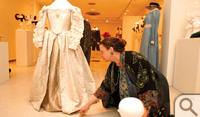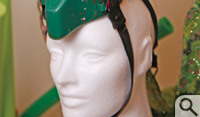Corsets & doublets & fans. Oh, my!
After 25 years of designing theatre costumes, Patricia Wesp's is one show that must go on.
“The audience doesn’t leave singing the costumes.” It’s a bit of advice Patricia Wesp has carried from her undergraduate days at William and Mary. But Wesp, associate professor of theatre and veteran costume designer, knows how to make a costume sing. Or laugh.
“I have been extremely fortunate to dress people funny for a living,” says Wesp, who is universally known as “Tric” (pronounced “Trish”). “It’s a great privilege to be able to earn a living this way—sitting on the floor doing a whacky craft project.”
 Whacky crafts aside, her passions—theatre, literature and art—are
intrinsically linked. At a summer retrospective, “What’s That On Your
Head?,” visitors were treated to creations ranging from Lady Capulet’s
gown, from the Virginia Shakespeare Festival’s 2007 production of Romeo and Juliet—to the ram and the owl in Batboy: The Musical from William and Mary Theatre’s 2004 season.
Whacky crafts aside, her passions—theatre, literature and art—are
intrinsically linked. At a summer retrospective, “What’s That On Your
Head?,” visitors were treated to creations ranging from Lady Capulet’s
gown, from the Virginia Shakespeare Festival’s 2007 production of Romeo and Juliet—to the ram and the owl in Batboy: The Musical from William and Mary Theatre’s 2004 season.
The exhibit, celebrating the past 25 years of Wesp’s costume design, ran from July through late August at Andrews Hall. Some creations were made from fabrics rare and exotic, others dime-store finds. As the name of the show suggests, it included many, many headpieces—headpieces being the artist’s favorite. No matter how whimsical or fun, each article of clothing or accessory represents the execution of a scholarly vision.
“The longer I’ve done this, the more intrigued with the historic research I have become. I’m increasingly fascinated with the opportunity to work with original garments, in museum collections and with historic objects,” Wesp said.
National influence
Wesp’s reputation and professional influence go far beyond the stage of Phi Beta Kappa Memorial Hall. This fall she received a three-year, $112,000 grant from the U.S. Institute of Museum and Library Services, on behalf of the Costume Society of America, a professional non-profit.
The grant will fund two ongoing projects at the national level, administered by Wesp. The first is the Museum Professionals Preservation Workshop, offering intensive training sessions for staff and volunteers at primarily small museums with varied collections and limited resources. The second part will fund the Costume Society’s Angels Project, in which professionals—textile and costume scholars, museum personnel, conservators, curators, students—donate a day’s labor to a small museum with a big problem/project.
“Next May we’re at a U.S. Army National Guard museum in New Orleans” says Wesp, “It was hit by both Katrina and Rita, and was under at least 12 feet of water twice in 2005
This past summer, during the Virginia Shakespeare Festival, Wesp worked on her fifth production of Romeo and Juliet (her third at William and Mary alone). It was a little different this time—deliberately set in Italy, but in the later Italian Renaissance, closer to the period in which Shakespeare lived.
“We were clearly responding to the Jamestown 1607 mania” she said, noting that other productions have set the play in the early Italian Renaissance or in England during the reign of Elizabeth I—with only a nod to “Italian” detail in the clothing.
To prepare for this production, her research took her back to the primary sources, to paintings in the later Italian Renaissance. First came the conceptual part, the design conferences—each designer asking questions and sharing examples, based on some of the ideas that Wesp had assembled from her initial research. From these conversations, she began the process of studying images and producing some visuals to show the director.
“I started searching for specific details, for characterizations or interpretations that might work well for a particular individual, and then selecting the visual images, compiling them into a photocopied collage for the director to respond to,” she said.
Behind the seams
Great care is taken to ensure that the clothes fit both the play and
the players. Next the garments are sewn and then adapted, as necessary,
to the movement of the performers or to the  changes that occur in the
rehearsal process.
changes that occur in the
rehearsal process.
Wesp rarely uses the term “costume,” and almost always calls her creations “clothes.” It’s an important distinction for a scholar-designer-artisan who is careful enough to begin her design with a careful study of the dress of subjects in period portraits. Lady Capulet’s gown, for instance, was inspired by Bronzino’s portrait of Eleanor of Toledo, circa 1550.
“The satisfaction comes from seeing the parts come together,” Wesp explained. In the case of Lady Capulet, the parts include “familiarity with the images from the period, finding the patterned fabric with an appropriate scale of the design, finding a solution to the construction problem that improves the weight and drape of the fabric so the garment moves in a more satisfactory manner, and being able to put the finished product on a performer who gives life to both the character and the dress and makes us believe that these are clothes belonging in the wardrobe of that character, not ‘costumes’ that somebody ‘designed’ for a play.”
Sometimes, it’s comic books
Not all the research is so highbrow. “Right now,” she said in September, “I’m working on Superman: The Musical and so I’ve been—God help me!—reading comic books and watching the George Reeves TV serial!”
 With only a full-time shop manager to assist her—who came on board
in 1997—Wesp relies on student interns and assistants, whose numbers,
experience and skill levels vary from year to year and production to
production. Often, she said, students become quite involved in the
process depending upon the tasks or production responsibilities they
assume.
With only a full-time shop manager to assist her—who came on board
in 1997—Wesp relies on student interns and assistants, whose numbers,
experience and skill levels vary from year to year and production to
production. Often, she said, students become quite involved in the
process depending upon the tasks or production responsibilities they
assume.
“I have a student working with me on Superman who has been doing some fairly specific research looking for images from around 1963, so that she can help me zero in on kinds of images that will suggest college students back then as opposed to college students today.”
Wesp also works closely with faculty colleagues like Professor of Dance Joan Gavaler. Currently they are working on a composition that Gavaler is creating, informed by her collaboration with Native American dancers and musicians.
“Joan is not trying to imitate or reproduce in any way—the piece is very much informed by the work that she is doing with Native American musicians who will be dressed in some of their regalia while they’re performing.”
“So for that one, there’s no script,” she explains. “You start
listening to music and you start watching movement patterns and you
start discussing some of these kinds of influences with other Native
American performers and you try to create something that is respectful
but at the same time individualized and also serves the choreographer’s
artistic intent. 
















